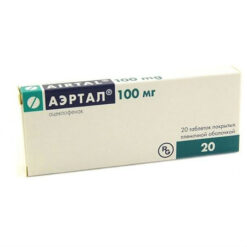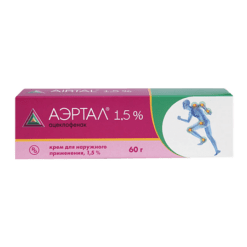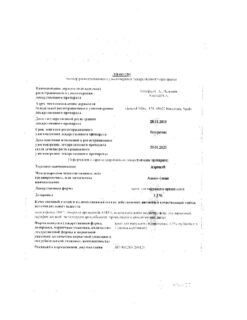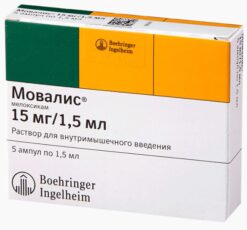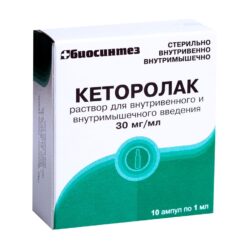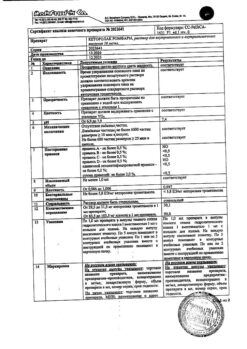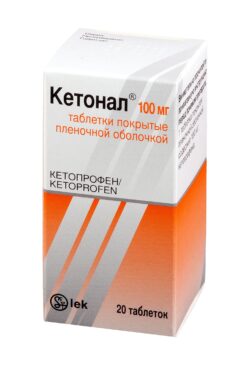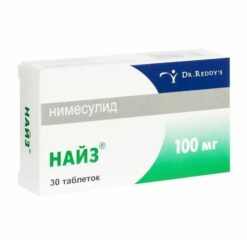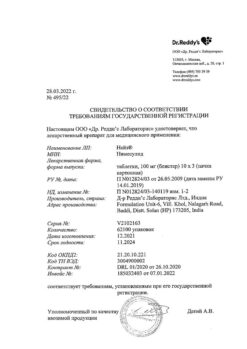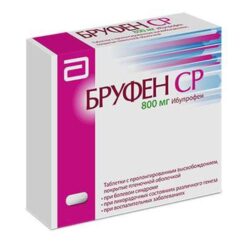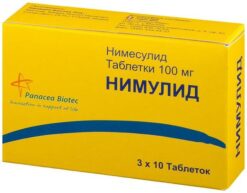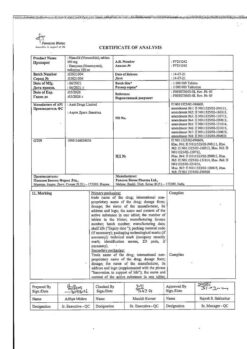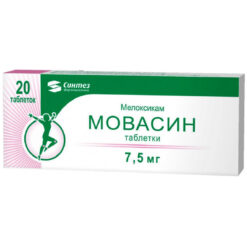No products in the cart.
Aertal, 100 mg 60 pcs.
€32.45 €27.04
Description
Pharmacodynamics:
Aceclofenac is a non-steroidal compound with anti-inflammatory and analgesic effect. Its mechanism of action is based on inhibition of prostaglandin synthesis.
Pharmacokinetics:
Absorption
Aceclofenac is rapidly absorbed after oral administration, bioavailability is almost 100%. Maximal concentration in blood plasma is reached 1.25-3 hours after intake. Simultaneous intake of food slows absorption, but does not affect its degree.
Distribution
Aceclofenac is highly bound to plasma proteins (>99.7%). Aceclofenac penetrates into the synovial fluid, where its concentration reaches 60% of its concentration in plasma. The volume of distribution is about 30 liters.
Metabolism
Aceclofenac is believed to be metabolized by the CYP2C9 isoenzyme. The main metabolite is 4-ONE-acetylophenac, which probably has minimal clinically significant effects. Various metabolites (including diclofenac and 4- OH-diclofenac) have been found.
Excretion
The average elimination half-life (t1/2) is 4-4.3 hours. Clearance is 5 l/h. About 2/3 of the dose taken is excreted by the kidneys, mainly as conjugated hydroxymetabolites. Only 1% of the dose after oral administration is excreted unchanged.
Pharmacokinetics in special groups of patients
Elderly patients (over 65 years)
Pharmacokinetics of aceclofenac in elderly patients is not changed.
Patients with hepatic impairment
A slower excretion of aceclofenac was observed in patients with moderate hepatic function after single administration of the drug. In a multiple-dose study, there were no differences in pharmacokinetic parameters between participants with mild to moderate liver cirrhosis and healthy volunteers when aceclofenac was administered 100 mg once daily.
Patients with renal impairment
No clinically significant differences in pharmacokinetic parameters were observed in patients with renal impairment of mild to moderate severity after a single dose compared to healthy volunteers.
Indications
Indications
For osteoarthritis, rheumatoid arthritis, ankylosing spondylitis and other diseases of the musculoskeletal system accompanied by pain (for example, glenohumeral periarthritis).
To eliminate pain of various etiologies (including lumbar pain, toothache and primary dysmenorrhea).
Pharmacological effect
Pharmacological effect
Pharmacodynamics:
Aceclofenac is a non-steroidal compound with anti-inflammatory and analgesic effects. Its mechanism of action is based on inhibition of prostaglandin synthesis.
Pharmacokinetics:
Suction
After oral administration, aceclofenac is rapidly absorbed, bioavailability is almost 100%. The maximum concentration in blood plasma is achieved 1.25-3 hours after administration. Concomitant food intake slows down absorption, but does not affect its degree.
Distribution
Aceclofenac is highly bound to plasma proteins (>99.7%). Aceclofenac penetrates into the synovial fluid, where its concentration reaches 60% of its plasma concentration. The distribution volume is approximately 30 l.
Metabolism
It is believed that aceclofenac is metabolized by the CYP2C9 isoenzyme. The main metabolite is 4-OH-aceclofenac, which probably has minimal clinically significant effects. Various metabolites have been detected (including diclofenac and 4-OH-diclofenac).
Removal
The average half-life (t1/2) is 4-4.3 hours. Clearance is 5 l/h. Approximately 2/3 of the dose taken is excreted by the kidneys, mainly in the form of conjugated hydroxymetabolites. Only 1% of the dose after oral administration is excreted unchanged.
Pharmacokinetics in special groups of patients
Elderly patients (over 65 years old)
The pharmacokinetics of aceclofenac in elderly patients does not change.
Patients with liver failure
After a single dose of the drug in patients with moderately reduced liver function, a slower elimination of aceclofenac was observed. In a multiple-dose study of aceclofenac 100 mg once daily, no differences in pharmacokinetic parameters were observed between participants with mild to moderate liver cirrhosis and healthy volunteers.
Patients with renal failure
In patients with mild or moderate renal impairment, no clinically significant differences in pharmacokinetic parameters were observed after a single dose compared to healthy volunteers.
Special instructions
Special instructions
Adverse events can be minimized by using the lowest effective dose and reducing the duration of treatment necessary to control symptoms (see Dosage and Administration).
The simultaneous use of aceclofenac with other NSAIDs should be avoided. including selective cyclooxygenase-2 (COX-2) inhibitors.
Aceclofenac should be taken with caution and under medical supervision in patients with the following conditions, as there is a risk of exacerbation of the disease (see section “Side Effects”):
Symptoms indicating the presence of diseases of the gastrointestinal tract, including its upper and lower sections.
A history of ulcers, bleeding or perforation of the gastrointestinal tract. Ulcerative colitis (beyond exacerbation).
Crohn’s disease (not exacerbation).
Hematological diseases, systemic lupus erythematosus (SLE), porphyria, hematopoiesis disorders.
Effect on the gastrointestinal tract
Bleeding, ulcers or perforation of the gastrointestinal tract with a fatal outcome were observed when taking any NSAIDs during any period of treatment, both in the presence of symptoms and a history of serious gastrointestinal diseases (peptic ulcer of the stomach and duodenum, Crohn’s disease, ulcerative colitis, etc.), and without them.
The risk of bleeding, ulceration and gastrointestinal perforation increases with increasing dose of NSAIDs in patients with a history of peptic ulcer disease, especially if it was accompanied by bleeding or perforation (see section “Contraindications”), as well as in elderly patients. These patients should take the minimum effective dose of the drug. They require combination therapy with protective drugs (for example, misoprostol or proton pump inhibitors). Such treatment is necessary for patients who take small doses of aspirin or other drugs that negatively affect the gastrointestinal tract (see section “Interaction with other drugs”).
Patients with a history of gastrointestinal disease, including the elderly, should report any unusual gastrointestinal symptoms (especially bleeding), including when initially taking the drug. Particular caution should be exercised in patients concomitantly taking medications that may increase the risk of bleeding or ulceration, such as systemic corticosteroids, anticoagulants (warfarin), selective serotonin reuptake inhibitors, or antiplatelet agents (acetylsalicylic acid) (see section “Interactions with other drugs”).
If gastrointestinal bleeding or ulcers occur in patients taking Airtal®, it should be discontinued.
Cardiovascular and cerebrovascular effects
Patients with hypertension and/or mild to moderate congestive heart failure require appropriate monitoring as fluid retention and edema are associated with NSAID use.
Patients with chronic heart failure (class I according to the New York Heart Association classification) and patients with significant risk factors for developing complications from the cardiovascular system (for example, arterial hypertension, hyperlipidemia, diabetes mellitus, smoking) should begin treatment with aceclofenac only after an informed decision by the attending physician. Cardiovascular risks may depend on the dose and duration of treatment, so the drug should be prescribed at the lowest effective dose and for the shortest possible period of time. The patient’s need for symptomatic treatment should be periodically monitored and response to therapy assessed.
Aceclofenac should also be used with caution and under close medical supervision in patients with a history of cerebral hemorrhage.
Effect on liver and kidney functions
Taking NSAIDs can cause a dose-dependent decrease in prostaglandin formation and acute renal failure. The importance of prostaglandins in maintaining renal blood flow should be considered when taking the drug in patients with impaired cardiac, renal or hepatic function, in patients receiving diuretics or in patients after surgery, as well as in the elderly.
Caution should be exercised when prescribing the drug to patients with mild or moderate hepatic and renal dysfunction, as well as patients with other conditions predisposing to fluid retention in the body. In such patients, NSAIDs can lead to impaired renal function and fluid retention. Patients taking diuretics and those at increased risk of hypovolemia should also be careful when taking Airtal. It is necessary to prescribe the minimum effective dose and regular medical monitoring of renal function. The effect of the drug on renal function is usually reversible after discontinuation of aceclofenac.
Aceclofenac should be discontinued if changes in liver function tests persist or worsen, clinical signs or symptoms of liver disease develop, or other manifestations (eosinophilia, rash) occur. Hepatitis can develop without prodromal symptoms.
The use of NSAIDs in patients with hepatic porphyria may provoke an attack.
Hypersensitivity and skin reactions
Like other NSAIDs, the drug may cause allergic reactions, including anaphylactic/anaphylactoid reactions, early in the course of treatment. Severe skin reactions (some of which can be fatal), including exfoliative dermatitis, Stevens-Johnson syndrome and toxic epidermal necrolysis, have been very rare after taking NSAIDs (see section “Side effects”). The highest risk of these reactions occurring in patients is observed at the beginning of taking the drug, and the development of these adverse reactions is observed during the first month of taking the drug. If the first signs of skin rash, damage to mucous membranes or any other symptoms of hypersensitivity occur, you should immediately stop taking aceclofenac.
In some cases, chickenpox can cause skin and soft tissue infections. At present, the role of NSAIDs in worsening the course of these infections cannot be ruled out, so taking Airtal® should be avoided for chickenpox.
Hematological disorders
Aceclofenac can cause reversible inhibition of platelet aggregation (see section “Interaction with other drugs”).
Respiratory system disorders
Caution should be exercised when taking the drug in patients with a history of or current bronchial asthma, since taking NSAIDs may trigger the development of sudden bronchospasm in such patients.
Elderly patients (over 65 years old)
Caution should be exercised when taking the drug in elderly patients, as they are more likely to experience side effects (especially bleeding and gastrointestinal perforation) when taking NSAIDs. Complications can be fatal. Older patients are also more likely to suffer from kidney, liver, or cardiovascular diseases.
Long-term use
All patients receiving long-term treatment with NSAIDs. should be closely monitored (eg complete blood count, liver and kidney function monitoring).
Sodium content
The drug Airtal®, film-coated tablets, 100 mg is considered sodium-free. since 1 tablet contains less than 1 mmol (23 mg) sodium.
Impact on the ability to drive vehicles. Wed and fur.:
You should refrain from driving vehicles and operating machinery if you experience weakness, dizziness, vertigo or other disorders of the central nervous system while taking NSAIDs.
Active ingredient
Active ingredient
Aceclofenac
Composition
Composition
1 tablet contains:
Active ingredient: aceclofenac 100 mg.
Excipients: microcrystalline cellulose pH 102; microcrystalline cellulose pH 101; povidone K-30; glyceryl distearate, type I; croscarmellose sodium.
Film shell composition
Sepifilm 752 white: hypromellose; microcrystalline cellulose; titanium dioxide; macrogol stearate, type I.
Pregnancy
Pregnancy
Pregnancy
There are no data on the use of aceclofenac during pregnancy.
Inhibition of prostaglandin synthesis may adversely affect the course of pregnancy and/or the development of the embryo/fetus.
Data from epidemiological studies indicate an increased risk of miscarriage, heart disease and gastroschisis when using prostaglandin synthesis inhibitors in the early stages of pregnancy. The absolute risk of developing heart disease increases from less than 1% to approximately 1.5%. The risk increases with increasing dose and duration of treatment.
In animals, taking prostaglandin synthesis inhibitors leads to pre- and post-implantation fetal death and embryo-fetal mortality. There is also an increase in the incidence of various defects, including heart disease, in animals receiving prostaglandin synthesis inhibitors during organogenesis.
During the third trimester of pregnancy, all prostaglandin synthesis inhibitors may:
exhibit cardiopulmonary toxicity to the fetus (premature closure of the ductus arteriosus with the development of pulmonary hypertension);
cause impaired fetal renal function, which can progress to renal failure in combination with polyhydramnios.
In women at the end of pregnancy and newborns they may:
influence the duration of bleeding due to the antiplatelet effect, which can develop even after the use of very low doses;
suppress uterine contractions, causing delayed labor or prolonged labor. The drug Airtal® is contraindicated during pregnancy (see section “Contraindications”).
Breastfeeding period
It is necessary to stop breastfeeding or discontinue/abstain from aceclofenac therapy, taking into account the benefits of breastfeeding for the child and/or the benefits of therapy for the mother. There is no data on the excretion of aceclofenac in human milk; in preclinical studies with the administration of radioactive 14C-aceclofenac, no noticeable transfer of radioactivity into milk was observed.
The drug Airtal® is contraindicated during breastfeeding (see section “Contraindications”).
Fertility
The use of Airtal®, like other cyclooxygenase/prostaglandin synthesis inhibitors, may reduce fertility and is not recommended for women planning pregnancy. Women who are having difficulty conceiving or are undergoing evaluation for infertility should stop taking aceclofenac.
Contraindications
Contraindications
Hypersensitivity to aceclofenac and/or any of the excipients of the drug.
History of bronchospasm, urticaria, rhinitis after taking acetylsalicylic acid or other nonsteroidal anti-inflammatory drugs (NSAIDs) (complete or incomplete acetylsalicylic acid intolerance syndrome – rhinosinusitis, urticaria, polyps of the nasal mucosa, bronchial asthma).
History of bleeding or perforation of the gastrointestinal tract associated with taking NSAIDs. History of gastric or duodenal ulcer or bleeding (two or more clear and proven episodes of ulcer or bleeding).
Ulcerative colitis and Crohn’s disease (in the acute stage).
The period after coronary artery bypass surgery.
Acute bleeding or bleeding disorders or bleeding disorders (hemophilia).
Chronic heart failure (class II-IV according to the New York Heart Association classification), coronary heart disease, diseases of the peripheral arteries and/or cerebral arteries.
Severe liver failure or active liver disease.
Severe renal failure (creatinine clearance < 30 ml/min).
Pregnancy and breastfeeding.
Children under 18 years of age.
With caution:
History of liver, kidney and gastrointestinal tract diseases, bronchial asthma, arterial hypertension, decreased circulating blood volume (including immediately after major surgical interventions); chronic renal failure of mild to moderate severity (creatinine clearance 60-30 ml/min); chronic liver failure of mild to moderate severity; chronic heart failure (class I according to the New York Heart Association classification); history of ulcerative lesions of the gastrointestinal tract (GIT), the presence of Helicobacter pylori infection, Crohn’s disease (non-exacerbation), ulcerative colitis (non-exacerbation), symptoms indicating the presence of gastrointestinal diseases; SLE, porphyria, hematological diseases, hematopoietic disorders, dyslipidemia/hyperlipidemia, diabetes mellitus, smoking, old age, long-term use of NSAIDs, alcoholism, severe somatic diseases.
Side Effects
Side Effects
The most commonly observed complications are from the gastrointestinal tract. Stomach ulcers, perforation or bleeding from the gastrointestinal tract may occur, sometimes leading to death, especially in elderly patients (see section “Special Instructions”). Nausea, vomiting, diarrhea, bloating, constipation, dyspepsia, abdominal pain, melena, hematemesis, ulcerative stomatitis, exacerbation of colitis and Crohn’s disease have been observed when taking NSAIDs (see section “Special Instructions”). Gastritis is less common.
In connection with the use of NSAIDs, the development of adverse reactions from the cardiovascular system has been reported: edema, hypertension and heart failure.
Aceclofenac is metabolized to diclofenac and has a structural affinity for it. As evidenced by a large body of clinical and epidemiological data, diclofenac may increase the risk of arterial thrombosis (eg, myocardial infarction or stroke, especially when used in high doses or with prolonged use). Epidemiological data also indicate an increased risk of acute coronary syndrome and myocardial infarction associated with the use of aceclofenac (see sections “Contraindications” and “Special instructions”).
The following are adverse events reported in clinical studies and post-marketing surveillance; Adverse events are grouped according to Medical Dictionary for Regulatory Activities (MedDRA) organ system classes and frequency of occurrence:
Very common: ≥1/10
Common: ≥1/100 to <1/10Uncommon: ≥1/1000 to <1/100Rare: ≥1/10000 to <1/1000Very rare: <1/10000.Blood and lymphatic system disordersRarely: anemia.Very rare: bone marrow suppression, granulocytopenia, thrombocytopenia, neutropenia, hemolytic anemia.Immune system disordersRare: anaphylactic reactions, including shock, hypersensitivity.Nutritional and metabolic disordersVery rare: hyperkalemia.Mental disordersVery rare: depression, unusual dreams, insomnia.Nervous system disordersCommon: dizziness.Very rare: paresthesia, tremor, drowsiness, headache, dysgeusia (taste perversion).Visual disordersRare: visual impairment.Hearing and labyrinth disordersVery rare: vertigo, tinnitus.Cardiac disordersRare: heart failure.Very rare: palpitations.Vascular disordersRarely: increased blood pressure, worsening of arterial hypertension.Very rare: skin redness, hot flashes, vasculitis.Disorders of the respiratory system, chest and mediastinal organsRarely: shortness of breath (difficulty breathing).Very rare: bronchospasm.Gastrointestinal disordersCommon: dyspepsia, abdominal pain, nausea, diarrhea.Uncommon: flatulence, gastritis, constipation, vomiting, ulceration of the oral mucosa. Rarely: melena, ulceration of the gastrointestinal mucosa, hemorrhagic diarrhea, hemorrhages of the gastrointestinal mucosa.Very rare: stomatitis, vomiting blood, intestinal perforation, worsening of Crohn’s disease and ulcerative colitis, pancreatitis.Disorders of the liver and biliary tractOften: increased activity of liver enzymes.Very rare: liver damage (including hepatitis), increased alkaline phosphatase activity.Disorders of the skin and subcutaneous tissuesUncommon: itching, rash, dermatitis, urticaria.Rare: angioedema.Very rare: bullous reactions, including Stevens-Johnson syndrome and toxic epidermal necrolysis; purpura, eczema.Renal and urinary tract disordersUncommon: increased serum urea and creatinine concentrations.Very rare: nephrotic syndrome, renal failure.General disorders and disorders at the injection siteVery rare: swelling, increased fatigue, muscle spasms of the lower extremities.Laboratory and instrumental dataVery rare: weight gain.Other class-specific effects of NAIDsRenal and urinary tract disordersVery rare: interstitial nephritis.Disorders of the skin and subcutaneous tissuesIn isolated cases, serious skin and soft tissue infections have been observed when taking NSAIDs during chickenpox (see sections “Interaction with other drugs” and “Special instructions”).
Overdose
Overdose
There are no data on overdose of aceclofenac in humans.
Possible symptoms: nausea, vomiting, pain in the stomach, dizziness, drowsiness, headache.
Treatment: antacids, supportive and symptomatic treatment of complications such as arterial hypotension, renal failure, convulsions, gastrointestinal irritation, respiratory depression. Treatment of acute poisoning is gastric lavage as soon as possible, administration of activated charcoal in repeated doses. Forced diuresis, hemoperfusion and hemodialysis are not effective enough due to the high degree of binding of NSAIDs to blood proteins and their active metabolism.
Storage conditions
Storage conditions
Store at a temperature not exceeding 25 °C. Keep out of the reach of children.
Shelf life
Shelf life
3 years.
Manufacturer
Manufacturer
Gedeon Richter, Hungary
Additional information
| Shelf life | 3 years. |
|---|---|
| Conditions of storage | Store at a temperature not exceeding 25 °C. Keep out of the reach of children. |
| Manufacturer | Gedeon Richter Rus, Russia |
| Medication form | pills |
| Brand | Gedeon Richter Rus |
Other forms…
Related products
Buy Aertal, 100 mg 60 pcs. with delivery to USA, UK, Europe and over 120 other countries.


